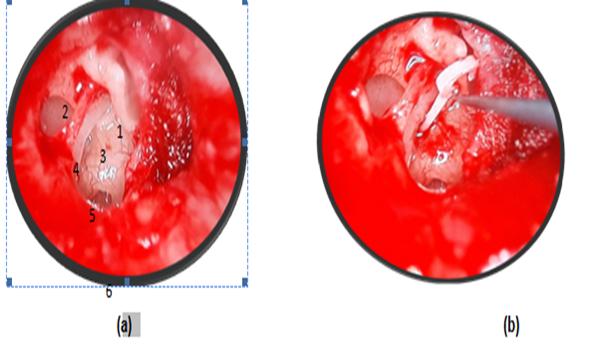
Ossicular chain reconstruction in a case of bilateral congenital absence of stapes suprastructure
Abstract
Middle ear ossicle malformations are an uncommon event. Among them, the congenital absence of stapes is a very rare condition that is seldom described in the literature. We report one such case of an 18 year old male, who presented with a long history of conductive deafness. An exploratory tympanotomy was performed under local anaesthesia with sedation and the absence of the stapes suprastructure, stapedeal tendon, obliterated oval window with hypoplastic footplate and an abnormal position of the facial nerve could be observed. A Teflon stapes piston was placed after created a fenestra in the oval window, crimped to handle of malleus and ossicular continuity was established. An intraoperative hearing assessment performed showed outstanding results. The pure tone average (PTA) for right ear was 63.3dB, left 60 dB conductive loss preoperatively and weber central with bilateral absent stapedeal reflex in impedence audiometry. Right ear was operated and six weeks following surgery the PTA for the right ear became 16.6 dB with closure of air-bone gap and weber lateralised to left. It is believed that stapes agenesis is related to an abnormal development of facial nerve, which by the fifth to sixth week of gestation would interpose between the otic capsule and the stapes blastema, preventing these structures from contacting. A long history of nonprogressive hearing loss from birth or early childhood is the key to reach a diagnosis. Several treatment options have been described in the literature including vestibulotomy, fenestration of the horizontal semicircular canal and hearing aids with bone anchored hearing aid (BAHA) being functionally most effective. Nevertheless it is ossicular chain reconstruction when feasible is the treatment of choice, which provided the best functional results as observed in our case.
Full Text:
PDFReferences
M. E. Reiber andM. K. Schwaber, “Congenital absence of stapes and facial nerve dehiscence,” Otolaryngology—Head and Neck Surgery, vol. 116, no. 2, p. 278, 1997.
H. Y. Park, D. H. Han, J. B. Lee, N. S. Han, Y.-H. Choung, and K. Park, “Congenital stapes anomalies with normal eardrum,” Clinical and Experimental Otorhinolaryngology, vol. 2, no. 1, pp. 33–38, 2009.
J. C. Casqueiro, J. Ramos-Fernandez, M. L. de La Vega, and J. Lopez-Moya, “Congenital absence of the stapes superstructure,” Otology and Neurotology, vol. 30, no. 8, pp. 1230 1231, 2009.
T. J. Hoare, C. J. Aldren,D.W.Morgan, andT.R.Bull, “Unusual case of bilateral conductive deafness,” Journal of Laryngology and Otology, vol. 104, no. 7, pp. 560–561, 1990.
K. Mcaskile and J. A. Sullivan, “Surgical management of congenital atresia of the ear,” The Journal of Laryngology and Otology, vol. 69, no. 12, pp. 765–785, 1955.
G. Keskin, E. Ust¨undaˇg, and A. Almac,, “A case of congenital bilateral stapes agenesis,” Kulak Burun Bogaz IhtisasDergisi, vol. 11, no. 6, pp. 175–178, 2003.
S. R. Fisher, J. C. Farmer Jr., and G. Baylin, “Bilateral congenital absence of the stapes and cervical spine anomaly,”TheAmerican Journal of Otology, vol. 4, no. 2, pp. 166–171, 1982.
Z. Yi, J. Yang, Z. Li, A. Zhou, and Y. Lin, “Bilateral congenital absence of stapes and oval window in 2 members of a family: etiology and management,” Otolaryngology—Head and Neck Surgery, vol. 128, no. 6, pp. 777–782, 2003.
P. W. Keong, R. Raman, and V. K. Khanijow, “Congenital absence of incus and head of stapes,” Archives of Otolaryngology— Head & Neck Surgery, vol. 113, no. 12, p. 1340, 1987.
F. R. Dom´ınguez, N. M. Merlos, P. N. Paule, I. Albaladejo Devis, M. P. M´armol, and L. M. A. Rodr´ıguez, “Congenital absence of the stapes suprastructure,” Acta Otorrinolaringologica Espanola,vol. 56, no. 10, pp. 488–490, 2005.
Refbacks
- There are currently no refbacks.

This work is licensed under a Creative Commons Attribution-NoDerivatives 4.0 International License.
An Initiative of The Tamil Nadu Dr MGR Medical University
 University Journal of Surgery and Surgical Specialities
University Journal of Surgery and Surgical Specialities